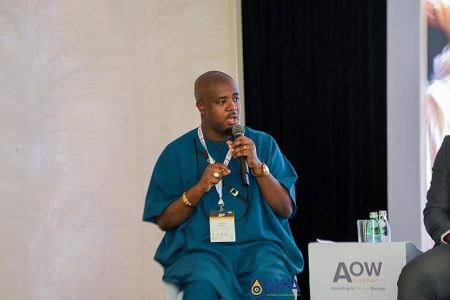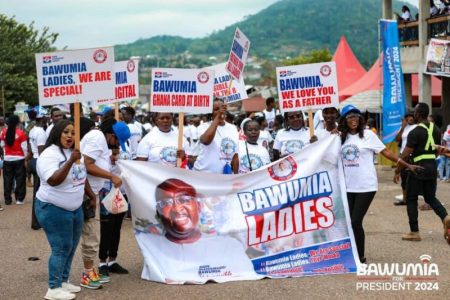Oheneni Adazoa, a Ghanaian radio personality, ignited a firestorm of controversy with an on-air proclamation defending her marital territory. During a live broadcast on Sompa FM, Adazoa, the host of a popular show, issued a stern warning to any woman who might consider pursuing her husband. Her words, delivered with fervent conviction, painted a vivid picture of her unwavering commitment to her marriage and the lengths to which she would go to protect it. “If you are a woman and you think you are Samson, come after my husband, and you will see. I will harm you,” she declared, her words reverberating through the airwaves and across social media platforms. This audacious statement immediately sparked a heated debate, dividing public opinion between those who applauded her fierce protectiveness and those who condemned her seemingly threatening stance.
The crux of Adazoa’s message centered on the sanctity of her marriage vows. She vehemently rejected the notion of divorce, stating emphatically, “As for me, Ama Genevieve, I am marrying my husband till I die. Divorce is not in my book.” This resolute declaration underscored her unwavering commitment to her husband and the permanence she envisioned for their union. It also highlighted the cultural context within which her pronouncements were made, where divorce might carry significant social stigma and be considered a last resort. Her statement, however, seemed to transcend the personal and venture into the realm of the prescriptive, suggesting a universal ideal for all marriages. This further fueled the controversy, raising questions about individual agency and the complexities of relationships.
Adazoa’s subsequent clarification attempted to soften the initial impact of her words, shifting the focus from physical harm to spiritual retribution. She explained that her threats were not meant to be interpreted literally, but rather as a warning of spiritual consequences. “I will not take you to any priest. But I will use a criminal prophesy to kill you,” she clarified. This explanation, however, did little to quell the ongoing debate. The introduction of “criminal prophecy” introduced a new element of ambiguity, raising further questions about the nature and extent of her intended actions. The term itself seemed to blend religious beliefs with potentially harmful intentions, creating a perplexing and unsettling image.
The inclusion of mothers in Adazoa’s warning added another layer of complexity to the already contentious issue. By admonishing mothers to “prepare” if their daughters dared to approach her husband, Adazoa extended her protective shield beyond a direct confrontation with potential rivals to encompass their families. This expanded the scope of her warning, implicating others in the perceived offense and creating a sense of collective responsibility. It also resonated with cultural norms where family plays a significant role in shaping individual behavior and upholding societal expectations.
The public reaction to Adazoa’s pronouncements was swift and sharply divided. Supporters lauded her unwavering commitment to her marriage, praising her as a fierce protector of her family. They viewed her words as a justified response to the perceived threat of infidelity, a bold assertion of her rights as a wife. This perspective highlighted the prevalence of infidelity concerns within relationships and the emotional toll they can take. Adazoa’s outspoken defense of her marriage, in this view, resonated with those who shared similar fears and anxieties.
Conversely, critics condemned her words as inflammatory and potentially dangerous. They argued that her statements, regardless of their intended meaning, could incite violence and promote harmful attitudes towards women. The concern was that her public pronouncements, particularly on a platform with a wide reach, could normalize and even encourage aggressive behavior in defense of relationships. This perspective emphasized the potential for misinterpretation and the risks associated with publicly endorsing potentially harmful actions, even under the guise of spiritual retribution. The debate highlighted the complex interplay between individual expression, cultural norms, and the responsible use of public platforms.
Beyond the immediate controversy, Adazoa’s pronouncements sparked a broader conversation about marriage, fidelity, and the expression of possessiveness in relationships. Her words, delivered with such passionate conviction, became a catalyst for discussions about the boundaries of acceptable behavior within relationships and the role of societal expectations in shaping individual choices. The incident also raised important questions about the power dynamics within marriages and the potential for possessiveness to escalate into controlling or abusive behavior.
The public discourse that followed Adazoa’s on-air warning touched upon deeper societal issues related to gender roles, expectations of women within marriage, and the complex interplay between love, possessiveness, and jealousy. The varied interpretations of her words reflected the diverse perspectives on these issues within the Ghanaian society and beyond. The controversy served as a reminder of the ongoing dialogue surrounding the evolving nature of relationships and the challenges of navigating the often-turbulent waters of love, commitment, and fidelity in a rapidly changing world.
The incident further highlighted the power and responsibility inherent in media platforms, particularly in the context of shaping public opinion and influencing social norms. Adazoa’s pronouncements, broadcast to a wide audience, sparked a national conversation about the boundaries of acceptable discourse and the potential consequences of inflammatory rhetoric. This underscored the role of media personalities as influencers and the ethical considerations that accompany such a position. It also raised questions about the responsibility of media outlets to ensure that their platforms are not used to promote harmful messages or incite violence.
The Oheneni Adazoa controversy became more than just a discussion about a single radio personality’s pronouncements. It evolved into a wider societal debate about the complexities of relationships, the challenges of maintaining fidelity, and the appropriate ways to express possessiveness and protect one’s marriage. The incident underscored the influence of cultural norms on individual behavior and the ongoing evolution of societal attitudes towards marriage, commitment, and the roles of men and women within these unions. It also highlighted the power of the media to shape public discourse and the responsibility that accompanies such influence.














